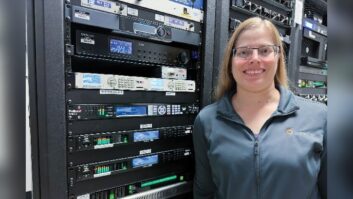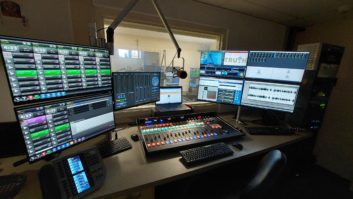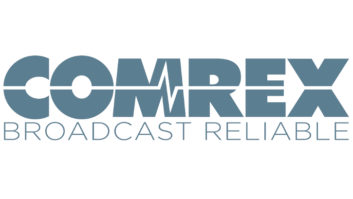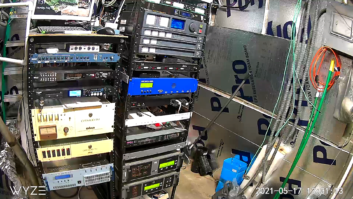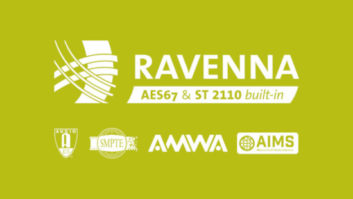Experts Share Practical Tips for Improving Performance and Avoiding Common Problems
Despite advances in remote technology and the availability of competing approaches, including ISDN, IP streaming audio and satellite telephones, the broadcast POTS codec, now almost a decade old, serves at many stations as an essential tool for events such as sports broadcasts and coverage of local news.
Perhaps not as cool or sexy as some of the other options for getting a signal back to the studio, the codec that uses “plain old phone service” provides quick, affordable audio connections via the near-ubiquitous medium of a dial-up telco line.
Equipment manufacturers and power users have devised numerous tricks to squeeze maximum performance and reliability from the POTS codec. We talked to several, seeking tips for Radio World readers.
Pound it home
Rolf Taylor, applications engineer for Telos Systems, says to reduce the time it takes for the network to make your connection, add a “#” at the end of the dial string. The “#” acts as a “send complete” signal, telling the switch it can process the call rather than waiting for more digits. Doing this can save a few seconds on most local calls, and 10 seconds or more on international calls.
White Papers and ResourcesATA Audio
www.ataaudio.com/pages/techsupport.htm
Comrex Corp.
- Modem Line Checklist
- All About POTS Codecs
- GSM Wireless Info Booklet
- Phone Line Basics
- Tips For Correcting Bad Phone Lines
Musicam USA
www.musicamusa.com, under Tech Tips
Telos Systems
www.telos-systems.com/techtalk/default.htm
- Troubleshooting the Public Switched Telephone Network
- How Do You Tell the Telco the Problem Is In Their Network?
Tieline Technology
- Tieline Precision Modem Technology Stabilizes POTS Codec Reliability
- The Application Of Stereo/dual Mono POTS Technology
Connection problems sometimes can be solved by using a different long-distance carrier, or reversing which end places the call. Even if the same carriers are involved, the routing of the call may be different.
Proper circuit balance is key to maintaining an acceptable noise floor on telco circuits. Both sides of the line should be terminated identically. Taylor adds that it is also important to use twisted pair cable. Avoid long lengths of flat modular cable to extend the POTS line to the codec. For runs longer than 10 feet, make up your own extension cords from Cat-3 or better twisted pair cable.
Even the non-twisted quad (red/green/black/yellow) common in most older installations should be avoided. Taylor recommends bypassing this wire and plugging twisted pair cable directly into the jack on the network interface.
When using borrowed lines, it’s important to disable call waiting by adding *70 to the beginning of the dial string. There is no way to disable call waiting on an inbound call, so check by dialing into the line in question while the codec is connected on a call.
Dave Powers, co-founder of Minuteman Communications in Boston, says one way to avoid problems with poor-quality dial-up lines is to connect the POTS codec to an ISDN line. Since most audio quality limitations are in the local loops at each end of the call, it makes sense to eliminate the one between the studio and the telephone company. In order to do this, at least one of the “B” channels must be configured for “alternate voice/data” capability when the line is ordered.
Powers said a special type of terminal adapter is also required, one that converts ISDN to POTS. An economical example is the ADTRAN Express 3000, which provides a POTS connection to an RJ-11 jack, and provides dial tone, ringing and call progress tones just like a regular analog line. A switch on the ADTRAN box switches between POTS and ISDN, although it may take a couple minutes for the box to handshake with the ISDN before the circuit is ready.
Last line
Kris Bobo, vice president of development at Comrex Corp., said that with the advent of fiber and digital technology, the quality of telco lines has improved considerably over the past 20 years. But it’s that last mile of copper that seems to cause most of the problems.
Telco line characteristics change over time due to temperature, humidity and other conditions. Therefore it is a good idea to disconnect the codec from the line and reconnect if possible in the middle of a long remote. Another tip is to be conservative with POTS codec use.
“If the line adapted down, it did so for a reason,” she said. “If you try and force it to work at the higher rate, the problems are likely to return.”
Mike Morris, sales manager for ATA Audio, agreed and said, “Another way to establish a solid connection is setting the codec at a fixed rate if this feature is available.
“For example, if you originally connected at 24 kbps, set the unit at the next lower rate, i.e. 21.6 kbps. By doing this, if the line degrades during the broadcast, you will already be at the lower rate. This enables you to maintain optimum performance of your codec by holding the line connection with no dropouts.”
He cited an instance in which a customer that broadcasts NFL games from Pittsburgh to Mexico on POTS would connect at 24 kbps; but after 30 minutes or so the line would drop to 21.6 kbps.
“He found this out by getting to location early and testing the line. Therefore, for the broadcast he set the codec at a fixed 21.6 kbps and had no problems with the broadcast, which at times could last well over three hours,” Morris said.
Corrosion of terminals is a common problem, particularly in locations near the ocean. The oxidation doesn’t have to be visible to cause noise or flaky circuits. Bobo said that a can of De-Oxit should be packed in every remote field kit.
Another tip from Bobo is for stations to hold on to their permanent telco loops. In some parts of the country, the phone company is already making way for DSL, and won’t install any new ISDN circuits.
Kevin Webb, president of Tieline Technology, offers these suggestions for getting set up when you don’t know what types of lines you’re dealing with. Connect an inexpensive palm phone to the line and check for a dial tone. If there is a tone, press 1 and listen for the any noise, hum and crosstalk in the background. If there is no dial tone, Webb said, you either have a dead line, or a digital line which you cannot use. In the worst case, you’ve destroyed a $10 disposable phone, rather than damaging an expensive codec.
In instances where a digital phone system or PBX is the only option, Webb recommends the Konnex Office Konnector. Costing about $110, the Konnector connects between the phone’s handset and the POTS codec, enabling a safe connection for the codec.
Calling Cairo
International calls can bring a host of unique problems. Taylor recalls a station remote from the Dominican Republic to Chicago. It turned out that calls between these locations only had audio in one direction, regardless of the long-distance carrier. ADPCM coding was being used, limiting the performance to 14.4 kbps. On the third day of the remote, a Monday, quality improved to 21.6 kbps. Taylor speculates that many of the tourists had left, thereby reducing traffic and making better circuits available.
Webb reports a difficulty getting satisfactory lines from the United States to Cuba. Due to the embargo between the two countries, there are no direct telephone connections. In at least one case, the calls were being routed via Spain.
While a logical approach to troubleshooting will solve most telco problems, Bobo recalls a few situations where creativity and thinking out of the box saved the day.
In one case, a station had satisfactory performance from a dial-up line during the day, but performance degraded the same time every evening. Investigation revealed that the lines passed a turkey farm, where solid-state dimmers controlled the lights in the barn. The RF interference from those dimmers turned out to be the problem. Bribing the farmer with movie passes to keep the lights off till the evening broadcast was finished saved the day.
In another instance, a station doing a remote from a hotel lobby had intermittent line problems that were traced to noisy brushes on an elevator motor. Once the offending elevator was identified, the “emergency off” button was pulled, and an “out of service” sign posted on the door.
Codecs occasionally are used for applications other than remote broadcasts. Webb cites several instances where stations have used the devices as STLs, both for short hops and long-distance connections. In a few cases, the connection has been in place for a year or more without the need to periodically reconnect to maintain quality.
He also said the criminal justice system uses POTS codecs so that court reporters can take depositions from witnesses without having to leave the court house. Closed captioning is another application for codecs, so the transcribers can listen to TV audio while at another site.
A different perspective on POTS comes from Art Constantine, vice president of business development for Musicam USA.
“As the radio industry heads toward HD Radio transmission with final broadcast bit rates as low as 48 kbps (or lower), and with the employment of various compression stages for intermediate program transmission and storage,” he said, “the use of POTS codecs at the originating end of a radio broadcast can and will severely degrade the quality of the final broadcast product.
“Consider an uncompressed, linear mono audio signal requiring about 750 kbps, encoded at, say, 24 kbps to squeeze through a POTS line. With no other coding present, it’s astonishing how good it sounds – OK, music excluded. But put a POTS codec anywhere in an audio chain along with other low bit-rate coding, and audio degrades, audibly.
“This may be OK, considering the alternative of no audio at all, or the cost and planning needed for higher rate circuits, like ISDN or high quality-of-service IP networks,” he continued. “But I think it’s important to remind broadcasters that, although POTS lines are ubiquitous, a determination of how much you can crunch the audio before listeners opt for their iPods instead should be made.”
Constantine said that as algorithms become even more efficient at transferring intelligible audio at ever-lower bit rates, products will continue to emerge to co-opt the technology. “And yes, someone will invariably use these products as a studio-to-transmitter link, all the while, wondering where their listeners have gone.”






